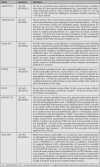Comparative effectiveness of novel oral anticoagulants for atrial fibrillation: evidence from pair-wise and warfarin-controlled network meta-analyses
- PMID: 23734288
- PMCID: PMC3670724
Comparative effectiveness of novel oral anticoagulants for atrial fibrillation: evidence from pair-wise and warfarin-controlled network meta-analyses
Abstract
Introduction: Novel oral anticoagulants have been tested against warfarin for atrial fibrillation, yet no direct comparison is available. We thus aimed to perform pair-wise (direct) and warfarin-adjusted network (i.e. indirect) meta-analyses of novel oral anticoagulants for atrial fibrillation.
Methods: Databases were searched for randomized warfarin-controlled trials of novel anticoagulants for non-valvular atrial fibrillation. The primary end-point was long-term stroke/systemic embolism. Odds ratios (95% intervals) were computed with RevMan and WinBUGS.
Results: Seven trials (52701 patients) were included, focusing on apixaban, dabigatran, edoxaban and rivaroxaban. Pair-wise meta-analysis showed that after a weighted average of 23 months these novel anticoagulants lead to significant reductions in the risk of stroke/systemic embolism (odds ratio=0.81 [0.71-0.92], I2=23%) and all cause death (odds ratio=0.88 [0.82-0.95], I2=0%) in comparison to warfarin. Network meta-analysis showed that apixaban and dabigatran proved similarly superior to warfarin in preventing stroke/systemic embolism (odds ratio=0.78 [0.62-0.96] for apixaban vs warfarin; odds ratio=0.66 [0.52-0.84] for high-dose dabigatran vs warfarin; odds ratio for apixaban vs high-dose dabigatran=1.17 [0.85-1.63]), but apixaban was associated with fewer major bleedings (odds ratio=0.73 [0.57-0.93]) and drug discontinuations (odds ratio=0.64 [0.52-0.78]) than dabigatran. Rivaroxaban did not reduce stroke/systemic embolism (odds ratio=0.87 [0.71-1.07]) or major bleedings in comparison to warfarin (odds ratio=0.87 [0.71-1.07]) and was associated with more major bleedings in comparison to apixaban (odds ratio=1.52 [1.19-1.92]). Data for edoxaban were inconclusive.
Conclusions: Novel oral anticoagulants appear as a very promising treatment option for atrial fibrillation.
Keywords: apixaban; atrial fibrillation; dabigatran; meta-analysis; rivaroxaban; systematic review; warfarin.
Conflict of interest statement
Figures







References
-
- European Heart Rhythm Association. European Association for Cardio-Thoracic Surgery , Camm A J. Guidelines for the management of atrial fibrillation: the Task Force for the Management of Atrial Fibrillation of the European Society of Cardiology (ESC). Eur Heart J. 2010;31:2369–2429. - PubMed
-
- Testa L, Biondi-Zoccai G G, Dello Russo A. et al. Rate-control vs. rhythm-control in patients with atrial fibrillation: a meta-analysis. Eur Heart J. 2005;26:2000–2006. - PubMed
-
- Andersen L V, Vestergaard P, Deichgraeber P. et al. Warfarin for the prevention of systemic embolism in patients with non-valvular atrial fibrillation: a meta-analysis. Heart. 2008;94:1607–1613. - PubMed
-
- Rietbrock S, Heeley E, Plumb J, van Staa T. Chronic atrial fibrillation: Incidence, prevalence, and prediction of stroke using the Congestive heart failure, Hypertension, Age >75, Diabetes mellitus, and prior Stroke or transient ischemic attack (CHADS2) risk stratification scheme. Am Heart J. 2008;156:57–64. - PubMed
